SiO2/SiC Nanowire Surfaces as a Candidate Biomaterial for Bone Regeneration
Abstract
1. Introduction
2. Materials and Methods
2.1. Sample Preparation
2.1.1. Epitaxial Layers
2.1.2. Nanowires
2.2. Morphological Analysis
2.3. Plasma Treatment
2.4. Contact Angle Measurements
2.5. Biological Assays
2.5.1. Cell Culture
2.5.2. Indirect-Contact Cytotoxicity Assay
2.5.3. Osteoblastic Proliferation Assay
3. Results
3.1. Morphological Analysis and Contact Angle Measurements of Epitaxial Layers
3.2. Morphological Analysis and Contact Angle Measurements of Nanowires
3.3. Biological Assays
4. Discussion
5. Conclusions
Author Contributions
Funding
Informed Consent Statement
Data Availability Statement
Acknowledgments
Conflicts of Interest
References
- Burg, K.J.; Holder, W.D., Jr.; Culberson, C.R.; Beiler, R.J.; Greene, K.G.; Loebsack, A.B.; Roland, W.D.; Eiselt, P.; Mooney, D.J.; Halberstadt, C.R. Comparative study of seeding methods for three-dimensional polymeric scaffolds. J. Biomed. Mater. Res. 2000, 51, 642–649. [Google Scholar] [PubMed]
- Gugliandolo, A.; Fonticoli, L.; Trubiani, O.; Rajan, T.S.; Marconi, G.D.; Bramanti, P.; Mazzon, E.; Pizzicannella, J.; Diomede, F. Oral Bone Tissue Regeneration: Mesenchymal Stem Cells, Secretome, and Biomaterials. Int. J. Mol. Sci. 2021, 22, 5236. [Google Scholar] [CrossRef] [PubMed]
- Bakhshandeh, B.; Zarrintaj, P.; Oftadeh, M.O.; Keramati, F.; Fouladiha, H.; Sohrabi-Jahromi, S.; Ziraksaz, Z. Tissue engineering; strategies, tissues, and biomaterials. Biotechnol. Genet. Eng. Rev. 2017, 33, 144–172. [Google Scholar] [PubMed]
- Girón, J.; Kerstner, E.; Medeiros, T.; Oliveira, L.; Machado, G.M.; Malfatti, C.F.; Pranke, P. Biomaterials for bone regeneration: An orthopedic and dentistry overview. Braz. J. Med. Biol. Res. 2021, 54, e11055. [Google Scholar]
- Battafarano, G.; Rossi, M.; De Martino, V.; Marampon, F.; Borro, L.; Secinaro, A.; Del Fattore, A. Strategies for Bone Regeneration: From Graft to Tissue Engineering. Int. J. Mol. Sci. 2021, 22, 1128. [Google Scholar] [CrossRef] [PubMed]
- Dec, P.; Modrzejewski, A.; Pawlik, A. Existing and Novel Biomaterials for Bone Tissue Engineering. Int. J. Mol. Sci. 2022, 24, 529. [Google Scholar]
- Carotenuto, F.; Politi, S.; Ul Haq, A.; De Matteis, F.; Tamburri, E.; Terranova, M.L.; Teodori, L.; Pasquo, A.; Di Nardo, P. From Soft to Hard Biomimetic Materials: Tuning Micro/Nano-Architecture of Scaffolds for Tissue Regeneration. Micromachines 2022, 13, 780. [Google Scholar]
- Teng, C.; Tong, Z.; He, Q.; Zhu, H.; Wang, L.; Zhang, X.; Wei, W. Mesenchymal Stem Cells–Hydrogel Microspheres System for Bone Regeneration in Calvarial Defects. Gels 2022, 8, 275. [Google Scholar] [CrossRef]
- Sun, L.; Guo, J.; Chen, H.; Zhang, D.; Shang, L.; Zhang, B.; Zhao, Y. Tailoring Materials with Specific Wettability in Biomedical Engineering. Adv. Sci. 2021, 8, 2100126. [Google Scholar]
- Lagonegro, P.; Trevisi, G.; Nasi, L.; Parisi, L.; Manfredi, E.; Lumetti, S.; Rossi, F.; Macaluso, G.M.; Salviati, G.; Galli, C. Osteoblasts preferentially adhere to peaks on micro-structured titanium. Dent. Mater. J. 2018, 37, 278–285. [Google Scholar] [CrossRef]
- Kamath, S.; Bhattacharyya, D.; Padukudru, C.; Timmons, R.B.; Tang, L. Surface chemistry influences implant-mediated host tissue responses. J. Biomed. Mater. Res. A 2008, 86, 617–626. [Google Scholar] [CrossRef]
- Nath, N.; Hyun, J.; Ma, H.; Chilkoti, A. Surface engineering strategies for control of protein and cell interactions. Surf. Sci. 2004, 570, 98–110. [Google Scholar]
- Wang, Y.X.; Robertson, J.L.; Spillman, W.B., Jr.; Claus, R.O. Effects of the chemical structure and the surface properties of polymeric biomaterials on their biocompatibility. Pharm. Res. 2004, 21, 1362–1373. [Google Scholar] [CrossRef] [PubMed]
- Ahmad, D.; van den Boogaert, I.; Miller, J.; Presswell, R.; Hussam, J. Hydrophilic and hydrophobic materials and their applications. Energy Sources Part A Recovery Util. Environ. Eff. 2018, 40, 2686–2725. [Google Scholar]
- Drelich, J.; Chibowski, E.; Meng, D.D.; Terpilowski, K. Hydrophilic and superhydrophilic surfaces and materials. Soft Matter 2011, 7, 9804–9828. [Google Scholar]
- Ghezzi, B.; Lagonegro, P.; Pece, R.; Parisi, L.; Bianchi, M.; Tatti, R.; Verucchi, R.; Attolini, G.; Quaretti, M.; Macaluso, G.M. Osteoblast adhesion and response mediated by terminal-SH group charge surface of SiOxCy nanowires. J. Mater. Sci. Mater. Med. 2019, 30, 43. [Google Scholar]
- Parisi, L.; Ghezzi, B.; Bianchi, M.G.; Toffoli, A.; Rossi, F.; Bussolati, O.; Macaluso, G.M. Titanium dental implants hydrophilicity promotes preferential serum fibronectin over albumin competitive adsorption modulating early cell response. Mater. Sci. Eng. C 2020, 117, 111307. [Google Scholar]
- Toffoli, A.; Parisi, L.; Bianchi, M.G.; Lumetti, S.; Bussolati, O.; Macaluso, G.M. Thermal treatment to increase titanium wettability induces selective proteins adsorption from blood serum thus affecting osteoblasts adhesion. Mater. Sci. Eng. C 2020, 107, 110250. [Google Scholar]
- Fernández-Rodríguez, M.; Sánchez Treviño, A.Y.; De Luna-Bertos, E.; Ramos Torrecillas, J.; García-Martínez, O.; Ruiz, C.; Rodríguez-Valverde, M.A.; Cabrerizo-Vílchez, M. Wettability and osteoblastic cell adhesion on ultrapolished commercially pure titanium surfaces: The role of the oxidation and pollution states. J. Adhes. Sci. Technol. 2014, 28, 1207–1218. [Google Scholar] [CrossRef]
- Kim, B.; Kim, M.; Yoo, S.; Nam, S.K. Atomistic insights on hydrogen plasma treatment for stabilizing High-k/Si interface. Appl. Surf. Sci. 2022, 593, 153297. [Google Scholar] [CrossRef]
- Zhang, H.; Kumagai, A.; Xu, G.; Ishibashi, K. Low-Temperature Atomic Hydrogen Treatment of SiO2/Si Structures. Jpn. J. Appl. Phys. 2003, 42, 6252. [Google Scholar] [CrossRef]
- Miyagawa, S.; Gotoh, K.; Ogura, S.; Wilde, M.; Kurokawa, Y.; Fukutani, K.; Usami, N. Effect of hydrogen plasma treatment on the passivation performance of TiOx on crystalline silicon prepared by atomic layer deposition. J. Vac. Sci. Technol. A 2020, 38, 022410. [Google Scholar] [CrossRef]
- Mews, M.; Conrad, E.; Kirner, S.; Mingirulli, N.; Korte, L. Hydrogen Plasma Treatments of Amorphous/Crystalline Silicon Heterojunctions. Energy Procedia 2014, 55, 827–833. [Google Scholar]
- Gupta, V.; Madaan, N.; Jensen, D.S.; Kunzler, S.C.; Linford, M.R. Hydrogen Plasma Treatment of Silicon Dioxide for Improved Silane Deposition. Langmuir 2013, 29, 3604–3609. [Google Scholar] [CrossRef]
- Parikh, A.N.; Liedberg, B.; Atre, S.V.; Ho, M.; Allara, D.L. Correlation of Molecular Organization and Substrate Wettability in the Self-Assembly of n-Alkylsiloxane Monolayers. J. Phys. Chem. 1995, 99, 9996–10008. [Google Scholar] [CrossRef]
- Yonenaga, I. Thermo-mechanical stability of wide-bandgap semiconductors: High temperature hardness of SiC, AlN, GaN, ZnO and ZnSe. Phys. B Condens. Matter 2001, 308–310, 1150–1152. [Google Scholar] [CrossRef]
- La Via, F.; Severino, A.; Anzalone, R.; Bongiorno, C.; Litrico, G.; Mauceri, M.; Schoeler, M.; Schuh, P.; Wellmann, P. From thin film to bulk 3C-SiC growth: Understanding the mechanism of defects reduction. Mater. Sci. Semicond. Process. 2018, 78, 57–68. [Google Scholar]
- Viguier, B.; Zor, K.; Kasotakis, E.; Mitraki, A.; Clausen, C.H.; Svendsen, W.E.; Castillo-Leon, J. Development of an electrochemical metal-ion biosensor using self-assembled peptide nanofibrils. ACS Appl. Mater. Interfaces 2011, 3, 1594–1600. [Google Scholar] [CrossRef]
- Tian, B.; Lieber, C.M. Design, synthesis, and characterization of novel nanowire structures for photovoltaics and intracellular probes. Pure Appl. Chem. 2011, 83, 2153–2169. [Google Scholar] [PubMed]
- Santavirta, S.; Takagi, M.; Nordsletten, L.; Anttila, A.; Lappalainen, R.; Konttinen, Y.T. Biocompatibility of silicon carbide in colony formation test in vitro. A promising new ceramic THR implant coating material. Arch. Orthop. Trauma Surg. 1998, 118, 89–91. [Google Scholar] [CrossRef] [PubMed]
- Hashiguchi, K.; Hashimoto, K. Mechanical and Histological Investigations on Pressureless Sintered SiC Dental Implants. Okajimas Folia Anat. Jpn. 1999, 75, 281–296. [Google Scholar] [CrossRef][Green Version]
- Godignon, P. SiC materials and technologies for sensors development. Mater. Sci. Forum 2005, 483–485, 1009–1014. [Google Scholar] [CrossRef]
- Yakimova, R.; Petoral, R.M.; Yazdi, G.R.; Vahlberg, C.; Lloyd Spetz, A.; Uvdal, K. Surface functionalization and biomedical applications based on SiC. J. Phys. D Appl. Phys. 2007, 40, 6435–6442. [Google Scholar] [CrossRef]
- Huczko, A.; Dąbrowska, A.; Savchyn, V.; Popov, A.I.; Karbovnyk, I. Silicon carbide nanowires: Synthesis and cathodoluminescence. Phys. Status Solidi B 2009, 246, 2806–2808. [Google Scholar] [CrossRef]
- Zhao, Q.; Ju, B.; Zhao, K.; Zhan, J.; Liu, M.; Zhang, N.; Qian, J.; Xiu, Z.; Kang, P.; Yang, W. Effect of Reinforcement Size on Mechanical Behavior of SiC-Nanowires-Reinforced 6061Al Composites. Materials 2022, 15, 8484. [Google Scholar] [CrossRef]
- Monnink, S.H.; Van Boven, A.J.; Peels, H.O.; Tigchelaar, I.; de Kam, P.J.; Crijns, H.J.; van Oeveren, W. Silicon-carbide coated coronary stents have low platelet and leukocyte adhesion during platelet activation. J. Investig. Med. 1999, 47, 304–310. [Google Scholar]
- Li, X.; Wang, X.; Bondokov, R.; Morris, J.; An, Y.H.; Sudarshan, T.S. Micro/nanoscale mechanical and tribological characterization of SiC for orthopedic applications. J. Biomed. Mater. Res. B Appl. Biomater. 2005, 72, 353–361. [Google Scholar] [CrossRef]
- Lagonegro, P.; Rossi, F.; Galli, C.; Smerieri, A.; Alinovi, R.; Pinelli, S.; Rimoldi, T.; Attolini, G.; Macaluso, G.; Macaluso, C.; et al. A cytotoxicity study of silicon oxycarbide nanowires as cell scaffold for biomedical applications. Mater. Sci. Eng. C 2017, 73, 465–471. [Google Scholar] [CrossRef]
- Oliveros, A.; Guiseppi-Elie, A.; Saddow, S.E. Silicon carbide: A versatile material for biosensor applications. Biomed. Microdevices 2013, 15, 353–368. [Google Scholar] [CrossRef]
- Saddow, S.E. Silicon Carbide Materials for Biomedical Applications. In Silicon Carbide Biotechnology; Springer: Berlin/Heidelberg, Germany, 2012. [Google Scholar]
- Adamski, R.; Siuta, D. Mechanical, Structural, and Biological Properties of Chitosan/Hydroxyapatite/Silica Composites for Bone Tissue Engineering. Molecules 2021, 26, 1976. [Google Scholar] [CrossRef]
- Cacchioli, A.; Ravanetti, F.; Alinovi, R.; Pinelli, S.; Rossi, F.; Negri, M.; Bedogni, E.; Campanini, M.; Galetti, M.; Goldoni, M.; et al. Cytocompatibility and cellular internalization mechanisms of SiC/SiO2 nanowires. Nano Lett. 2014, 14, 4368–4375. [Google Scholar] [CrossRef] [PubMed]
- Coletti, C.; Jaroszeski, M.J.; Pallaoro, A.; Hoff, A.M.; Iannotta, S.; Saddow, S.E. Biocompatibility and wettability of crystalline SiC and Si surfaces. In Proceedings of the 2007 29th Annual International Conference of the IEEE Engineering in Medicine and Biology Society, Lyon, France, 22–26 August 2007; Volume 2007, pp. 5850–5853. [Google Scholar]
- Bosi, M.; Watts, B.E.; Attolini, G.; Ferrari, C.; Frigeri, C.; Salviati, G.; Poggi, A.; Mancarella, F.; Roncaglia, A.; Martínez, O.; et al. Growth and Characterization of 3C-SiC Films for Micro Electro Mechanical Systems (MEMS) Applications. Cryst. Growth Des. 2009, 9, 4852–4859. [Google Scholar] [CrossRef]
- Bosi, M.; Attolini, G.; Negri, M.; Frigeri, C.; Buffagni, E.; Ferrari, C.; Rimoldi, T.; Cristofolini, L.; Aversa, L.; Tatti, R.; et al. Optimization of a buffer layer for cubic silicon carbide growth on silicon substrates. J. Cryst. Growth 2013, 383, 84–94. [Google Scholar] [CrossRef]
- Attolini, G.; Rossi, F.; Negri, M.; Dhanabalan, S.C.; Bosi, M.; Boschi, F.; Lagonegro, P.; Lupo, P.; Salviati, G. Growth of SiC NWs by vapor phase technique using Fe as catalyst. Mater. Lett. 2014, 124, 169–172. [Google Scholar] [CrossRef]
- Dhanabalan, S.C.; Negri, M.; Rossi, F.; Attolini, G.; Fabbri, F.; Campanini, M.; Bosi, M.; Salviati, G. Effects of growth parameters on SiC/SiO2 core/shell nanowires radial structure. Mater. Sci. Forum 2013, 740–742, 494–497. [Google Scholar] [CrossRef]
- Attolini, G.; Rotonda, P.M.; Cornelissen, C.; Mazzera, M.; Bosi, M. Plasma Treatment of 3C-SiC Surfaces. Mater. Sci. Forum 2013, 740–742, 287–290. [Google Scholar] [CrossRef]
- Ghezzi, B.; Lagonegro, P.; Attolini, G.; Rotonda, P.M.; Cornelissen, C.; Ponraj, J.S.; Parisi, L.; Passeri, G.; Rossi, F.; Macaluso, G.M. Hydrogen plasma treatment confers enhanced bioactivity to silicon carbide-based nanowires promoting osteoblast adhesion. Mater. Sci. Eng. C 2021, 121, 111772. [Google Scholar] [CrossRef]
- Rossi, F.; Fabbri, F.; Attolini, G.; Bosi, M.; Watts, B.E.; Salviati, G. TEM and SEM-CL Studies of SiC Nanowires. Mater. Sci. Forum 2010, 645–648, 387–390. [Google Scholar] [CrossRef]
- Fabbri, F.; Rossi, F.; Attolini, G.; Salviati, G.; Dierre, B.; Sekiguchi, T.; Fukata, N. Luminescence properties of SiC/SiO2 core–shell nanowires with different radial structure. Mater. Lett. 2012, 71, 137–140. [Google Scholar] [CrossRef]
- Negri, M.; Rossi, F.; Attolini, G.; Fabbri, F.; Dhanabalan, S.C.; Boschi, F.; Bosi, M.; Nardi, M.V.; Salviati, G. Cubic Silicon Carbide Nanowires. In Exotic Properties of Carbon Nanomatter: Advances in Physics and Chemistry; Putz, M.V., Ori, O., Eds.; Springer: Dordrecht, The Netherlands, 2015. [Google Scholar]
- Thomas, R.R.; Kaufman, F.B.; Kirleis, J.T.; Beisky, R.A. Wettabilily of Polished Silicon Oxide Surfaces. J. Electrochem. Soc. 1996, 143, 643–648. [Google Scholar] [CrossRef]
- Martinez, N.Y.; Reidy, R.F. Wettability of silicon, silicon dioxide, and organosilicate glass. Master’s Thesis, University of North Texas Libraries, UNT Digital Library, Denton, TX, USA, 2009. [Google Scholar]
- Galli, C.; Parisi, L.; Piergianni, M.; Smerieri, A.; Passeri, G.; Guizzardi, S.; Costa, F.; Lumetti, S.; Manfredi, E.; Macaluso, G.M. Improved scaffold biocompatibility through anti-Fibronectin aptamer functionalization. Acta Biomater. 2016, 42, 147–156. [Google Scholar] [CrossRef] [PubMed]
- Parisi, L.; Galli, C.; Bianchera, A.; Lagonegro, P.; Elviri, L.; Smerieri, A.; Lumetti, S.; Manfredi, E.; Bettini, R.; Macaluso, G.M. Anti-fibronectin aptamers improve the colonization of chitosan films modified with D-(+) Raffinose by murine osteoblastic cells. J. Mater. Sci. Mater. Med. 2017, 28, 136. [Google Scholar] [CrossRef] [PubMed]
- Gatou, M.-A.; Vagena, I.-A.; Pippa, N.; Gazouli, M.; Pavlatou, E.A.; Lagopati, N. The Use of Crystalline Carbon-Based Nanomaterials (CBNs) in Various Biomedical Applications. Crystals 2023, 13, 1236. [Google Scholar] [CrossRef]
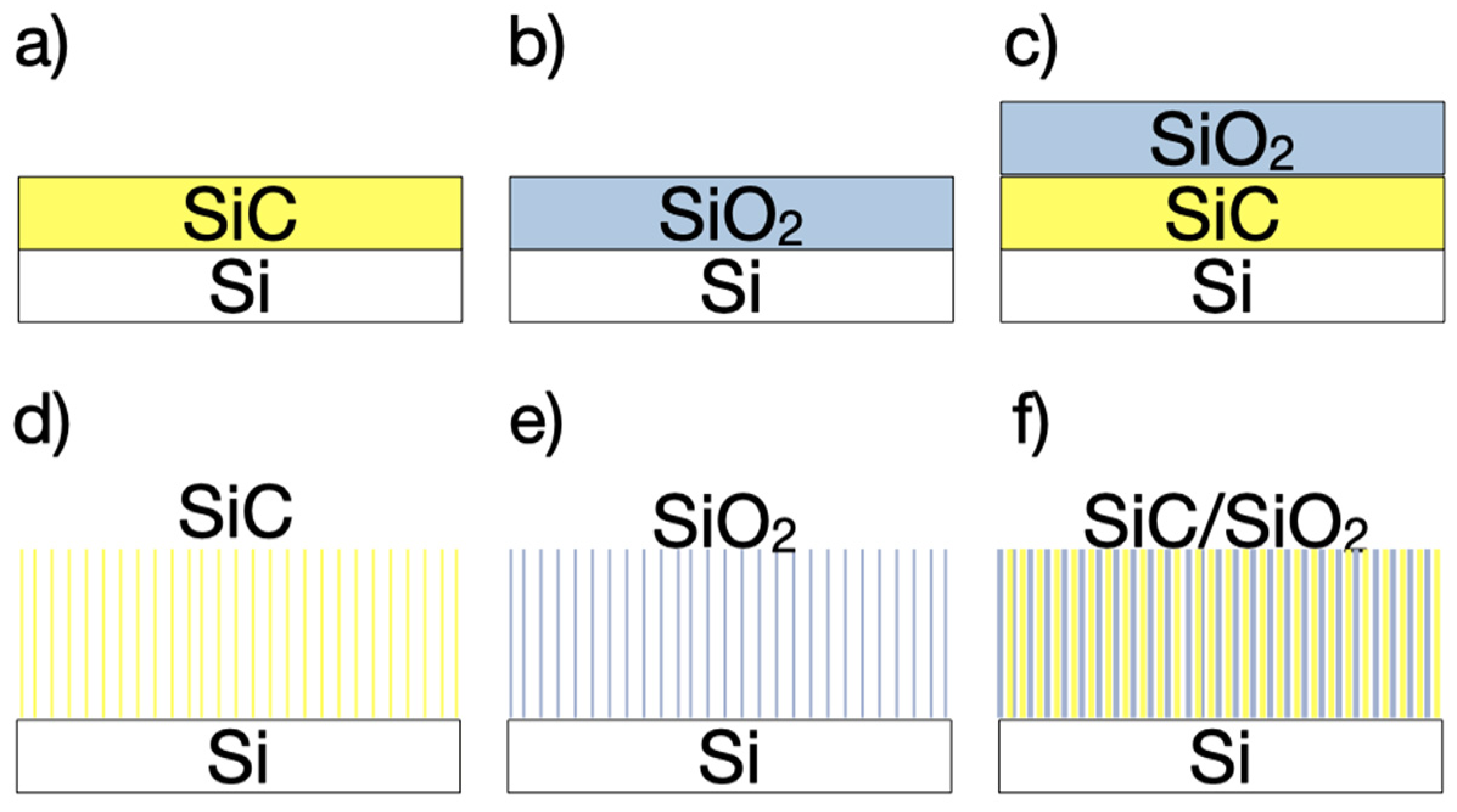
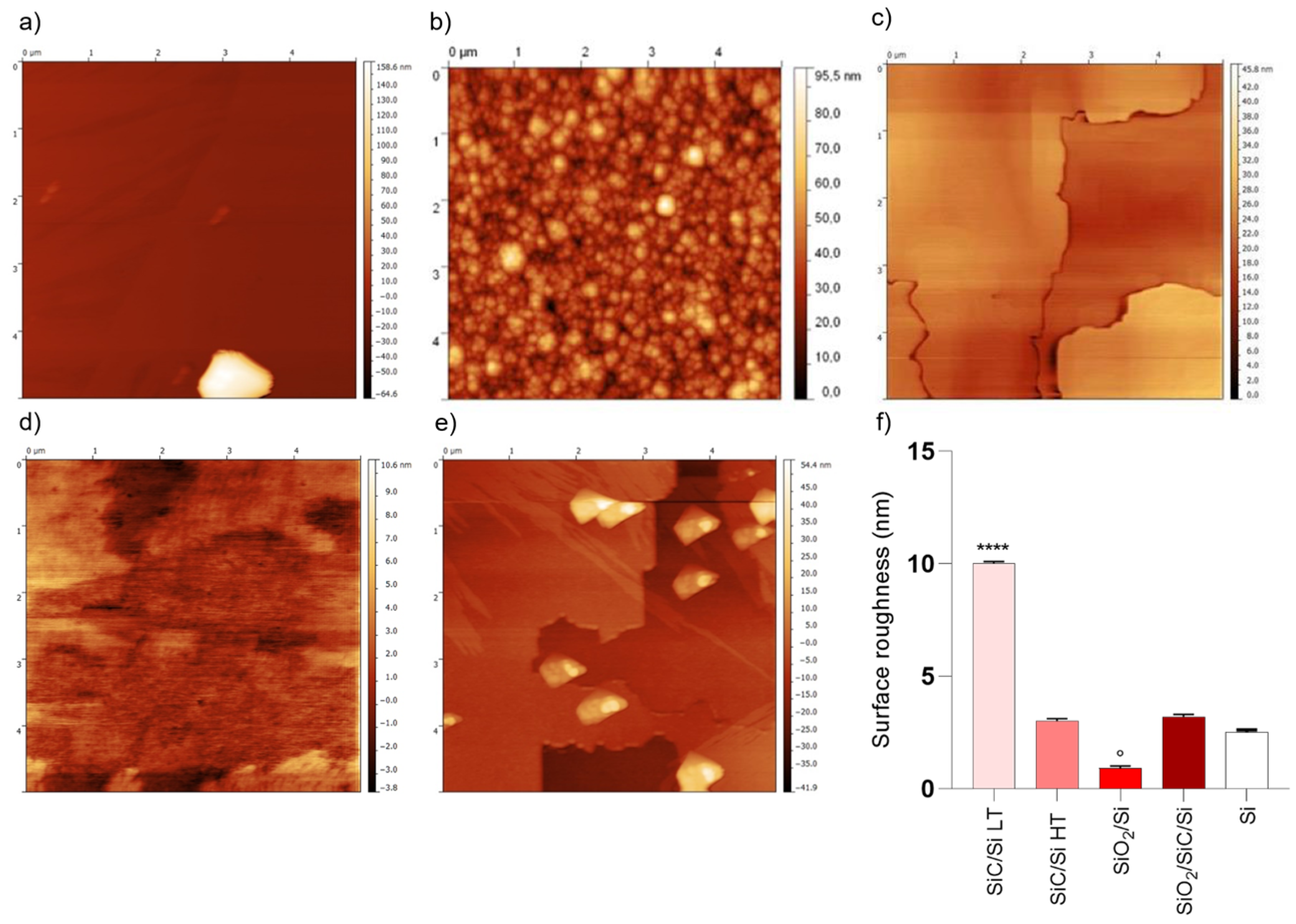
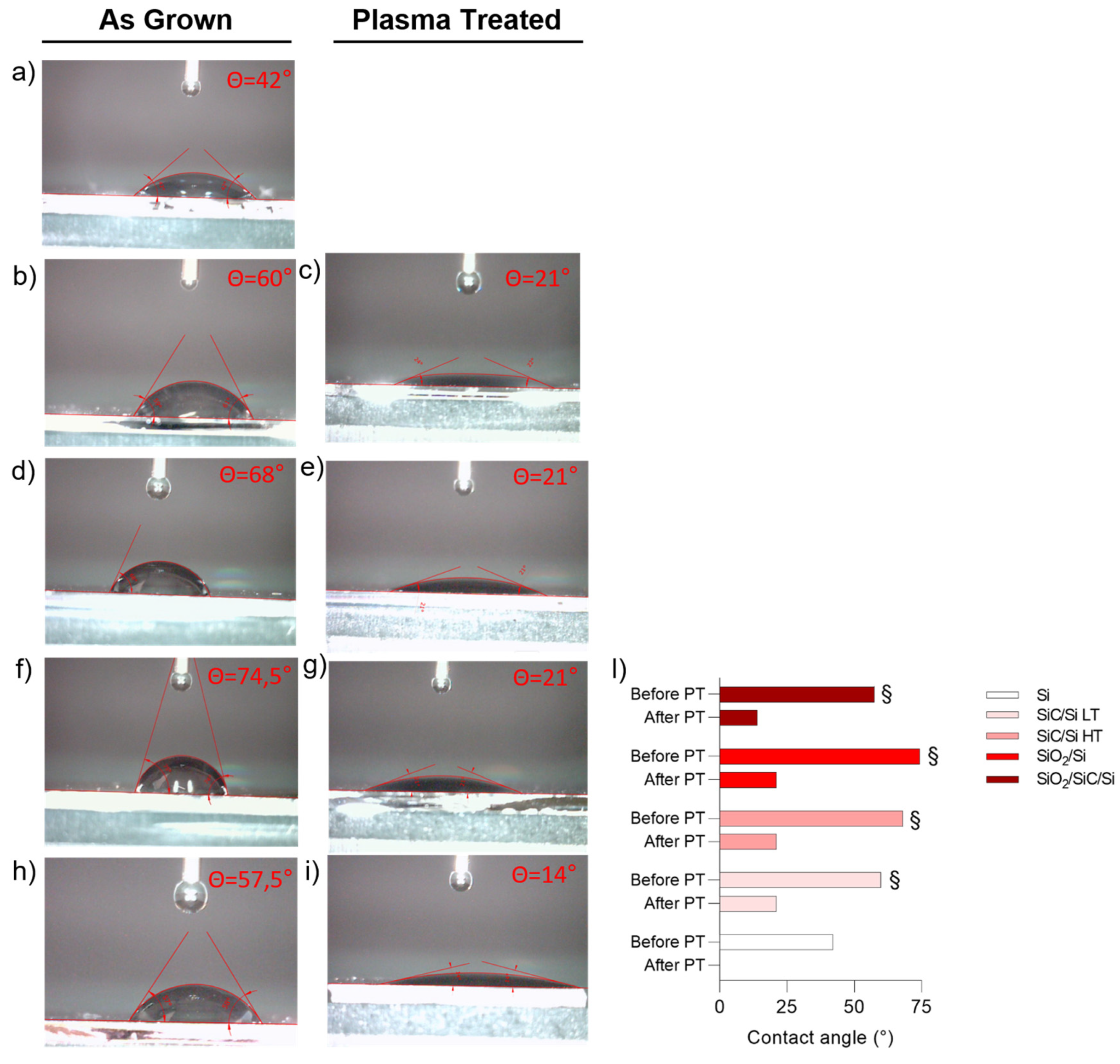
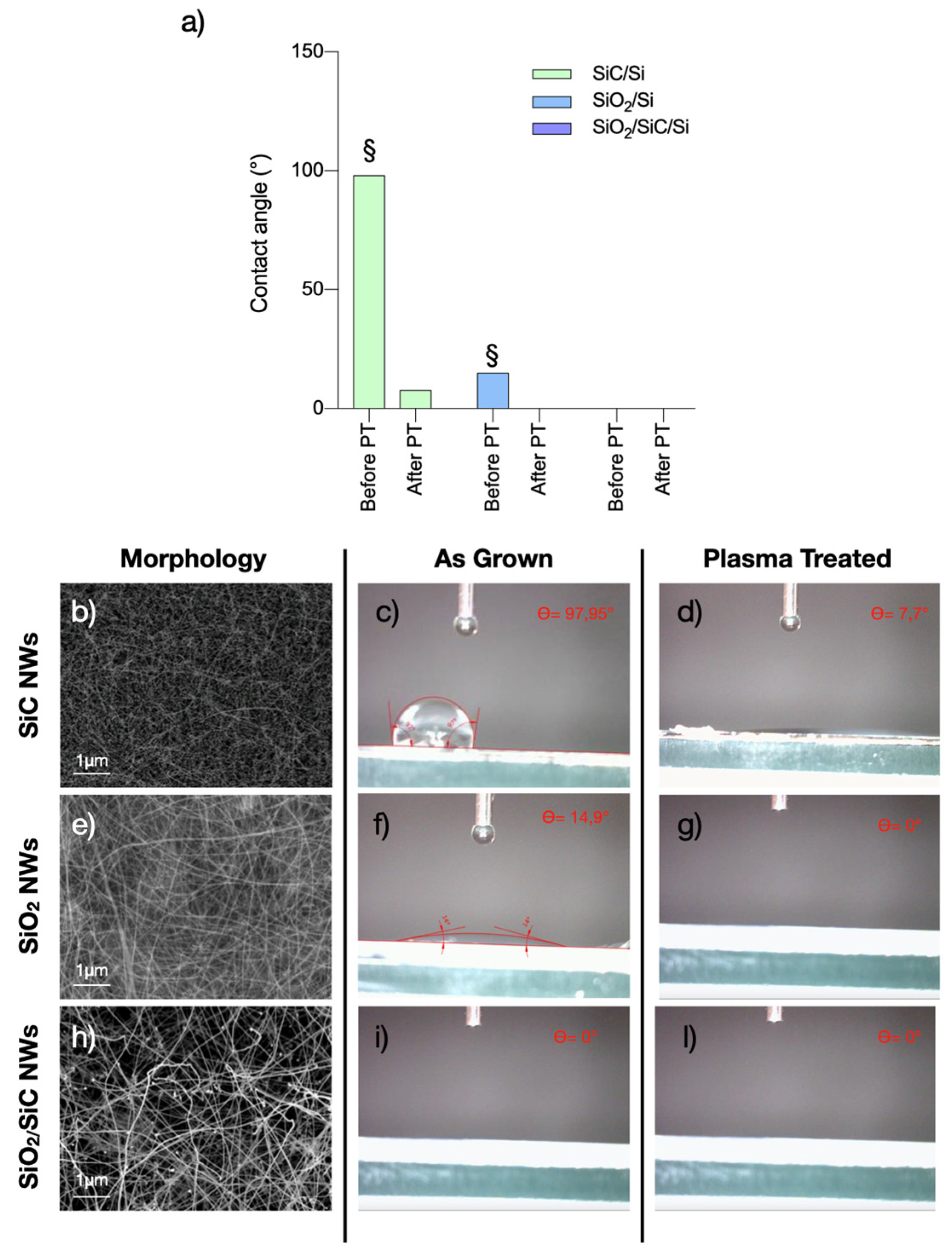
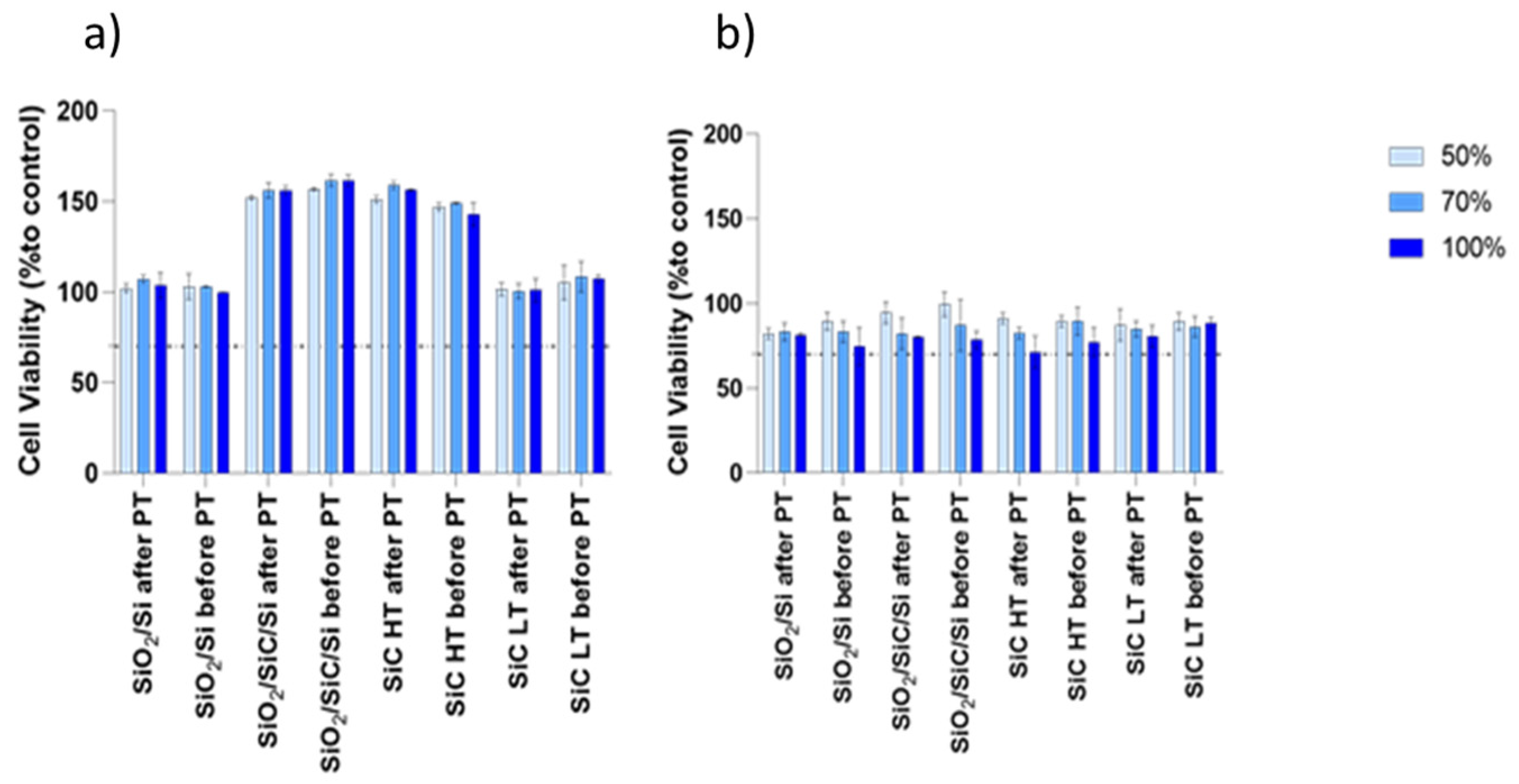
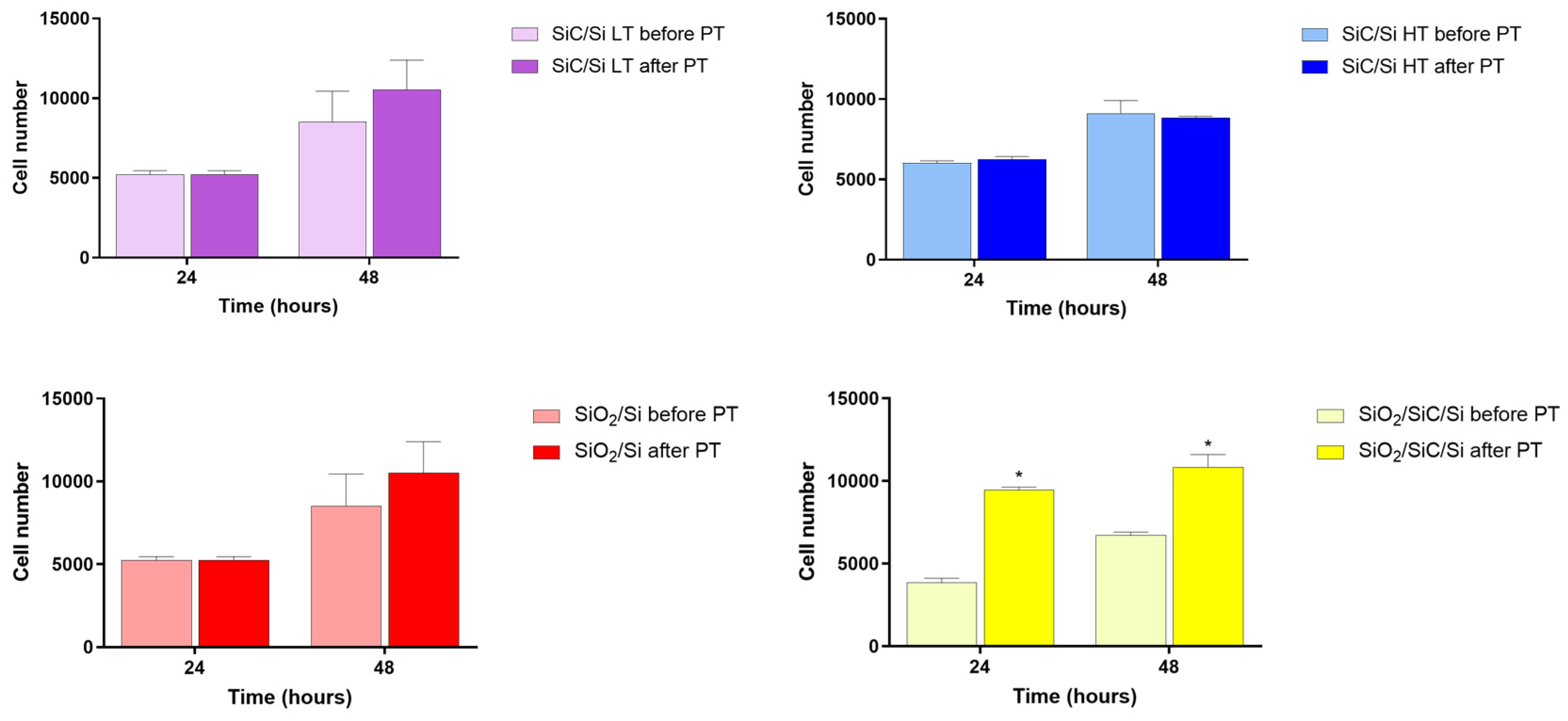
Disclaimer/Publisher’s Note: The statements, opinions and data contained in all publications are solely those of the individual author(s) and contributor(s) and not of MDPI and/or the editor(s). MDPI and/or the editor(s) disclaim responsibility for any injury to people or property resulting from any ideas, methods, instructions or products referred to in the content. |
© 2023 by the authors. Licensee MDPI, Basel, Switzerland. This article is an open access article distributed under the terms and conditions of the Creative Commons Attribution (CC BY) license (https://creativecommons.org/licenses/by/4.0/).
Share and Cite
Ghezzi, B.; Attolini, G.; Bosi, M.; Negri, M.; Lagonegro, P.; Rotonda, P.M.; Cornelissen, C.; Macaluso, G.M.; Lumetti, S. SiO2/SiC Nanowire Surfaces as a Candidate Biomaterial for Bone Regeneration. Crystals 2023, 13, 1280. https://doi.org/10.3390/cryst13081280
Ghezzi B, Attolini G, Bosi M, Negri M, Lagonegro P, Rotonda PM, Cornelissen C, Macaluso GM, Lumetti S. SiO2/SiC Nanowire Surfaces as a Candidate Biomaterial for Bone Regeneration. Crystals. 2023; 13(8):1280. https://doi.org/10.3390/cryst13081280
Chicago/Turabian StyleGhezzi, Benedetta, Giovanni Attolini, Matteo Bosi, Marco Negri, Paola Lagonegro, Pasquale M. Rotonda, Christine Cornelissen, Guido Maria Macaluso, and Simone Lumetti. 2023. "SiO2/SiC Nanowire Surfaces as a Candidate Biomaterial for Bone Regeneration" Crystals 13, no. 8: 1280. https://doi.org/10.3390/cryst13081280
APA StyleGhezzi, B., Attolini, G., Bosi, M., Negri, M., Lagonegro, P., Rotonda, P. M., Cornelissen, C., Macaluso, G. M., & Lumetti, S. (2023). SiO2/SiC Nanowire Surfaces as a Candidate Biomaterial for Bone Regeneration. Crystals, 13(8), 1280. https://doi.org/10.3390/cryst13081280






